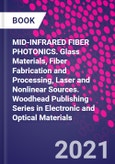Mid-Infrared Fibre Photonics:�Glass Materials, Fibre Fabrication and Processing, Laser Sources and Devicess�combines the latest glass chemistry, fibre fabrication and post processing techniques to provide a comprehensive reference on the fundamental science and latest research in fibre photonics for the mid-infrared range.
The book systematically reviews the key glass materials systems including fluorides, chalcogenides, and oxides. Each materials chapter includes discussion of composition, structure, thermal, optical and mechanical properties, extrinsic and intrinsic loss mechanisms, materials preparation and purification techniques.
Then Mid-Infrared Fibre Photonics: Glass Materials, Fibre Fabrication and Processing, Laser Sources and Devicess�covers the most relevant fabrication, post-processing, and spectroscopy techniques. Fibre sources are also addressed including fibre sources for continuous wave emission, pulsed emission, and broadband emission. The book concludes with a brief overview of important medical, sensing and defence applications.
Please Note: This is an On Demand product, delivery may take up to 11 working days after payment has been received.
Table of Contents
Section 1: Optical glasses and fibers for high nonlinearity, rare earth doping and high transparency in the mid-infrared
1. Chalcogenide materials for mid-wave infrared fibers
2. Fluoride glass and optical fiber fabrication
3. Oxide glass and optical fiber fabrication
Section 2: Post-processing of mid-infrared transparent optical fiber
4. Optical fibre fabrication for fluoride, chalcogenide and oxide glasses
5. Post-processing soft glass optical fibers
Section 3: Spectroscopy of the rare earth ions for mid-infrared emission
6. Energy transfer processes in rare-earth-doped glass fiber
7. Spectroscopy of the rare-earth-ion transitions in fluoride glasses
8. Breaking through the wavelength barrier: The state-of-play on rare-earth ion, mid-infrared fiber lasers for the 4-10 mm wavelength region
Section 4: Fiber sources for continuous wave emission
9. High-power continuous wave mid-infrared fluoride glass fiber lasers
Section 5: Fiber sources involving pulsed emission
10. Q-switched and gain-switched mid-infrared fluoride glass fiber lasers
11.� Mode-locked mid-infrared fiber systems
12.� Mid-infrared supercontinuum generation
13. Modeling mid-infrared fiber laser systems







